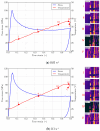Thermo-Mechanical Behavior and Strain Rate Sensitivity of 3D-Printed Polylactic Acid (PLA) below Glass Transition Temperature (Tg)
- PMID: 38891472
- PMCID: PMC11174730
- DOI: 10.3390/polym16111526
Thermo-Mechanical Behavior and Strain Rate Sensitivity of 3D-Printed Polylactic Acid (PLA) below Glass Transition Temperature (Tg)
Abstract
This study investigated the thermomechanical behavior of 4D-printed polylactic acid (PLA), focusing on its response to varying temperatures and strain rates in a wide range below the glass transition temperature (Tg). The material was characterized using tension, compression, and dynamic mechanical thermal analysis (DMTA), confirming PLA's strong dependency on strain rate and temperature. The glass transition temperature of 4D-printed PLA was determined to be 65 °C using a thermal analysis (DMTA). The elastic modulus changed from 1045.7 MPa in the glassy phase to 1.2 MPa in the rubber phase, showing the great shape memory potential of 4D-printed PLA. The filament tension tests revealed that the material's yield stress strongly depended on the strain rate at room temperature, with values ranging from 56 MPa to 43 MPA as the strain rate decreased. Using a commercial FDM Ultimaker printer, cylindrical compression samples were 3D-printed and then characterized under thermo-mechanical conditions. Thermo-mechanical compression tests were conducted at strain rates ranging from 0.0001 s-1 to 0.1 s-1 and at temperatures below the glass transition temperature (Tg) at 25, 37, and 50 °C. The conducted experimental tests showed that the material had distinct yield stress, strain softening, and strain hardening at very large deformations. Clear strain rate dependence was observed, particularly at quasi-static rates, with the temperature and strain rate significantly influencing PLA's mechanical properties, including yield stress. Yield stress values varied from 110 MPa at room temperature with a strain rate of 0.1 s-1 to 42 MPa at 50 °C with a strain rate of 0.0001 s-1. This study also included thermo-mechanical adiabatic tests, which revealed that higher strain rates of 0.01 s-1 and 0.1 s-1 led to self-heating due to non-dissipated generated heat. This internal heating caused additional softening at higher strain rates and lower stress values. Thermal imaging revealed temperature increases of 15 °C and 18 °C for strain rates of 0.01 s-1 and 0.1 s-1, respectively.
Keywords: 3D printing; 4D printing; shape memory polymer; smart materials; thermo-mechanical experiments.
Conflict of interest statement
The authors declare no conflicts of interest.
Figures













Similar articles
-
Probing the complex thermo-mechanical properties of a 3D-printed polylactide-hydroxyapatite composite using in situ synchrotron X-ray scattering.J Adv Res. 2018 Nov 16;16:113-122. doi: 10.1016/j.jare.2018.11.002. eCollection 2019 Mar. J Adv Res. 2018. PMID: 30899594 Free PMC article.
-
Prediction of The Mechanical Behavior of Polylactic Acid Parts with Shape Memory Effect Fabricated by FDM.Polymers (Basel). 2023 Feb 25;15(5):1162. doi: 10.3390/polym15051162. Polymers (Basel). 2023. PMID: 36904401 Free PMC article.
-
3D Printing of PLA/clay Nanocomposites: Influence of Printing Temperature on Printed Samples Properties.Materials (Basel). 2018 Oct 11;11(10):1947. doi: 10.3390/ma11101947. Materials (Basel). 2018. PMID: 30314390 Free PMC article.
-
Fabrication and Performance of Continuous 316 Stainless Steel Fibre-Reinforced 3D-Printed PLA Composites.Polymers (Basel). 2023 Dec 24;16(1):63. doi: 10.3390/polym16010063. Polymers (Basel). 2023. PMID: 38201728 Free PMC article. Review.
-
The Effects of Nucleating Agents and Processing on the Crystallization and Mechanical Properties of Polylactic Acid: A Review.Micromachines (Basel). 2024 Jun 12;15(6):776. doi: 10.3390/mi15060776. Micromachines (Basel). 2024. PMID: 38930746 Free PMC article. Review.
Cited by
-
Biocompatible Thermoplastics in Additive Manufacturing of Bone Defect Fillers: State-of-the-Art and Future Prospects.Materials (Basel). 2025 Aug 8;18(16):3723. doi: 10.3390/ma18163723. Materials (Basel). 2025. PMID: 40870041 Free PMC article. Review.
-
4D printing polymeric biomaterials for adaptive tissue regeneration.Bioact Mater. 2025 Feb 22;48:370-399. doi: 10.1016/j.bioactmat.2025.01.033. eCollection 2025 Jun. Bioact Mater. 2025. PMID: 40083775 Free PMC article. Review.
References
-
- Lee K.M., Koerner H., Vaia R.A., Bunning T.J., White T.J. Light-Activated Shape Memory of Glassy, Azobenzene Liquid Crystalline Polymer Networks. Soft Matter. 2011;7:4318–4324. doi: 10.1039/C1SM00004G. - DOI
-
- Heuchel M., Sauter T., Kratz K., Lendlein A. Thermally Induced Shape-Memory Effects in Polymers: Quantification and Related Modeling Approaches. J. Polym. Sci. Part B Polym. Phys. 2013;51:621–637. doi: 10.1002/polb.23251. - DOI
-
- Razzaq M.Y., Behl M., Nöchel U., Lendlein A. Magnetically Controlled Shape-Memory Effects of Hybrid Nanocomposites from Oligo(Omega-Pentadecalactone) and Covalently Integrated Magnetite Nanoparticles. Polymer. 2014;55:5953–5960. doi: 10.1016/j.polymer.2014.07.025. - DOI
-
- Schmidt A.M. Electromagnetic Activation of Shape Memory Polymer Networks Containing Magnetic Nanoparticles. Macromol. Rapid Commun. 2006;27:1168–1172. doi: 10.1002/marc.200600225. - DOI
Grants and funding
LinkOut - more resources
Full Text Sources
Miscellaneous

